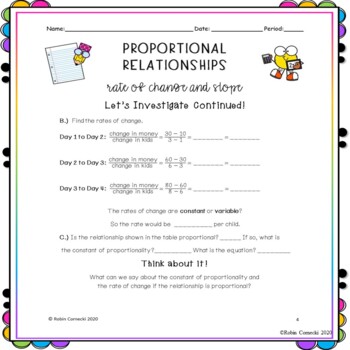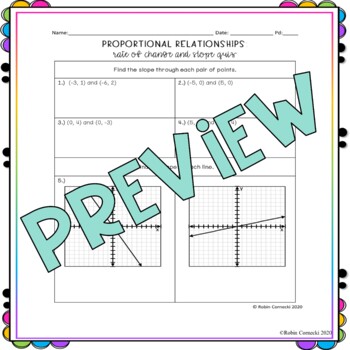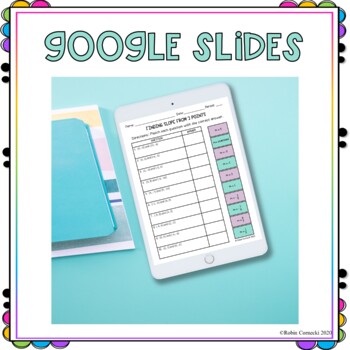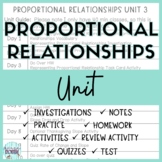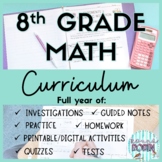Rate of Change and Slope Bundle
Robin Cornecki - Round Robin Math
523 Followers
Grade Levels
7th - 9th
Subjects
Resource Type
Standards
CCSS8.EE.B.6
CCSS8.F.B.4
CCSSMP7
Formats Included
- Zip
- Internet Activities
Pages
15 pages + Activity + Answer Key
Robin Cornecki - Round Robin Math
523 Followers
Compatible with Digital Devices
The Teacher-Author has indicated that this resource can be used for device-based learning.
Products in this Bundle (3)
Also included in
- Are you teaching Proportional Relationships to your 8th-grade math students? Look no further than with this complete Proportional Relationships Unit Bundle. Topics include Representing Proportional Relationships, Rate of Change and Slope, and Interpreting the Unit Rate as Slope. This ProportionalPrice $22.40Original Price $28.00Save $5.60
- Are you looking for an entire 8th Grade Math Curriculum with guided notes, activities, AND editable assessments? Look no further than this 8th-grade math GROWING curriculum full year bundle. The following 8th-grade Math Curriculum is wholly aligned with Common Core State Standards for 8th grade iPrice $292.80Original Price $366.00Save $73.20
Description
Teach your students everything they need to know about the Rate of Change and Slope. This Rate of Change and Slope resource includes finding the Rate of Change from tables, graphs, and calculating Slope from graphs, tables, and ordered pairs with the slope formula with this investigation, notes, practice, and activity resource.
✅ Includes:
- Investigation, Notes, Practice, Homework
- Digital and Printable Activity on Finding Slope between 2 points
- Editable Quiz
You may also like:
- Representing Proportional Relationships: Investigation, Notes, & Practice
- Exponents and Scientific Notation Unit Bundle
- Real Numbers Unit Bundle
Don't forget to leave a review to earn credit towards future resources at no extra cost to you!
Let's be social!
Total Pages
15 pages + Activity + Answer Key
Answer Key
Included
Teaching Duration
Other
Report this resource to TPT
Reported resources will be reviewed by our team. Report this resource to let us know if this resource violates TPT’s content guidelines.
Standards
to see state-specific standards (only available in the US).
CCSS8.EE.B.6
Use similar triangles to explain why the slope m is the same between any two distinct points on a non-vertical line in the coordinate plane; derive the equation 𝘺 = 𝘮𝘹 for a line through the origin and the equation 𝘺 = 𝘮𝘹 + 𝘣 for a line intercepting the vertical axis at 𝘣.
CCSS8.F.B.4
Construct a function to model a linear relationship between two quantities. Determine the rate of change and initial value of the function from a description of a relationship or from two (𝘹, 𝘺) values, including reading these from a table or from a graph. Interpret the rate of change and initial value of a linear function in terms of the situation it models, and in terms of its graph or a table of values.
CCSSMP7
Look for and make use of structure. Mathematically proficient students look closely to discern a pattern or structure. Young students, for example, might notice that three and seven more is the same amount as seven and three more, or they may sort a collection of shapes according to how many sides the shapes have. Later, students will see 7 × 8 equals the well remembered 7 × 5 + 7 × 3, in preparation for learning about the distributive property. In the expression 𝑥² + 9𝑥 + 14, older students can see the 14 as 2 × 7 and the 9 as 2 + 7. They recognize the significance of an existing line in a geometric figure and can use the strategy of drawing an auxiliary line for solving problems. They also can step back for an overview and shift perspective. They can see complicated things, such as some algebraic expressions, as single objects or as being composed of several objects. For example, they can see 5 – 3(𝑥 – 𝑦)² as 5 minus a positive number times a square and use that to realize that its value cannot be more than 5 for any real numbers 𝑥 and 𝑦.


